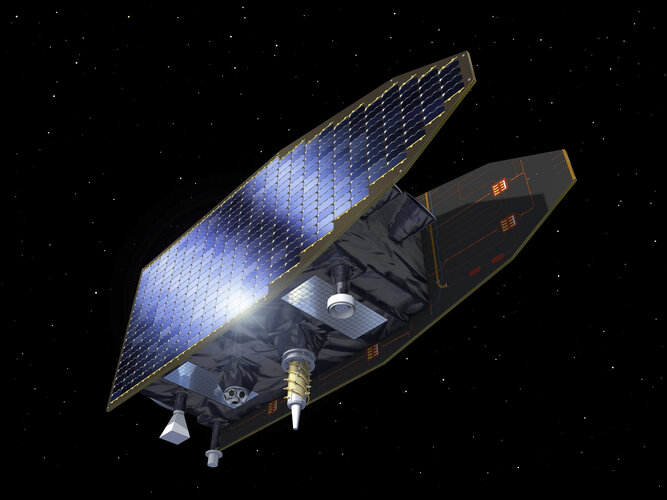Honda to test renewable tech in space soon
Monday, 07 April 2025 11:31 Honda will partner with US companies to test in orbit a renewable energy technology it hopes to one day deploy on the Moon's surface, the Japanese carmaker announced Friday.
The auto giant is developing a mechanism capable of generating electricity and oxygen continuously - enabling astronauts to breathe - thanks to solar energy and water known to be present in some lunar soils.
Now i
Honda will partner with US companies to test in orbit a renewable energy technology it hopes to one day deploy on the Moon's surface, the Japanese carmaker announced Friday.
The auto giant is developing a mechanism capable of generating electricity and oxygen continuously - enabling astronauts to breathe - thanks to solar energy and water known to be present in some lunar soils.
Now i Karman expands spacecraft production with advanced clean room facility
Monday, 07 April 2025 11:31 Karman Space and Defense (NYSE: KRMN), a prominent provider of precision-engineered systems for missiles, uncrewed aerial vehicles, and spacecraft, has unveiled a new ISO 8 clean room facility at its Washington site. This state-of-the-art space is purpose-built to handle the assembly and integration of next-generation space hardware, including lunar landers, satellite platforms, and habitat modu
Karman Space and Defense (NYSE: KRMN), a prominent provider of precision-engineered systems for missiles, uncrewed aerial vehicles, and spacecraft, has unveiled a new ISO 8 clean room facility at its Washington site. This state-of-the-art space is purpose-built to handle the assembly and integration of next-generation space hardware, including lunar landers, satellite platforms, and habitat modu Carbon Robotics debuts autonomous tractor system with live remote control capability
Monday, 07 April 2025 11:31 Carbon Robotics has unveiled Carbon AutoTractor, a new autonomy system that transforms conventional tractors into driverless machines, monitored and managed in real time by trained human operators. Built around the Carbon AI platform, the solution is designed to deliver continuous, dependable autonomous operations for farms seeking to scale up productivity and address labor shortages.
This
Carbon Robotics has unveiled Carbon AutoTractor, a new autonomy system that transforms conventional tractors into driverless machines, monitored and managed in real time by trained human operators. Built around the Carbon AI platform, the solution is designed to deliver continuous, dependable autonomous operations for farms seeking to scale up productivity and address labor shortages.
This A new path for quantum connections
Monday, 07 April 2025 11:31 Applied physicists at the Harvard John A. Paulson School of Engineering and Applied Sciences (SEAS) have developed a photon-routing device that could significantly enhance the interface between optical and microwave quantum systems, potentially enabling large-scale, modular quantum computing over existing telecom networks.
This innovation could pave the way for quantum computers that are n
Applied physicists at the Harvard John A. Paulson School of Engineering and Applied Sciences (SEAS) have developed a photon-routing device that could significantly enhance the interface between optical and microwave quantum systems, potentially enabling large-scale, modular quantum computing over existing telecom networks.
This innovation could pave the way for quantum computers that are n Mammals were shifting to ground life long before dinosaur extinction
Monday, 07 April 2025 11:31 New findings from the University of Bristol suggest that mammals had begun transitioning from arboreal habitats to terrestrial ones several million years prior to the asteroid strike that caused the extinction of the dinosaurs.
Published in the journal Palaeontology, the research highlights that numerous mammalian species were already adapting to life on the ground before the catastrophic
New findings from the University of Bristol suggest that mammals had begun transitioning from arboreal habitats to terrestrial ones several million years prior to the asteroid strike that caused the extinction of the dinosaurs.
Published in the journal Palaeontology, the research highlights that numerous mammalian species were already adapting to life on the ground before the catastrophic NASA uncovers complex teamwork in magnetic bacteria
Monday, 07 April 2025 11:31 In a breakthrough study, researchers backed by NASA have explored the remarkable cooperative behavior of a rare form of bacteria that function as if they were a unified multicellular entity. These organisms, known as multicellular magnetotactic bacteria (MMB), are the only bacteria currently known to display this specific type of obligate multicellularity, offering a compelling model for how com
In a breakthrough study, researchers backed by NASA have explored the remarkable cooperative behavior of a rare form of bacteria that function as if they were a unified multicellular entity. These organisms, known as multicellular magnetotactic bacteria (MMB), are the only bacteria currently known to display this specific type of obligate multicellularity, offering a compelling model for how com Smartphone sensor array reimagined as ultra-precise antimatter imaging system
Monday, 07 April 2025 11:31 In a major advance for antimatter research, scientists from CERN's AEgIS collaboration have engineered a groundbreaking imaging system by adapting the image sensors found in mobile phone cameras. The innovation aims to provide unprecedented spatial resolution in tracking the annihilation of antihydrogen particles, a vital step toward precisely measuring how antimatter responds to Earth's gravity
In a major advance for antimatter research, scientists from CERN's AEgIS collaboration have engineered a groundbreaking imaging system by adapting the image sensors found in mobile phone cameras. The innovation aims to provide unprecedented spatial resolution in tracking the annihilation of antihydrogen particles, a vital step toward precisely measuring how antimatter responds to Earth's gravity Sierra Space advances secure GPS tech for US Space Force initiative
Monday, 07 April 2025 11:31 Sierra Space has successfully showcased its Resilient GPS (R-GPS) satellite technology, a critical advancement for the U.S. Space Force's efforts to strengthen national defense through more robust navigation systems. Developed in partnership with General Dynamics Mission Systems, the demonstration validated the generation of all necessary GPS navigation signals for the R-GPS mission, addressing
Sierra Space has successfully showcased its Resilient GPS (R-GPS) satellite technology, a critical advancement for the U.S. Space Force's efforts to strengthen national defense through more robust navigation systems. Developed in partnership with General Dynamics Mission Systems, the demonstration validated the generation of all necessary GPS navigation signals for the R-GPS mission, addressing Potential NASA Earth science cuts highlight budget uncertainty
Monday, 07 April 2025 10:58
Some NASA Earth science missions have been told to prepare termination plans given the potential for major budget cuts in the agency’s overall science activities.
China’s megaconstellation launches could litter orbit for more than a century, analysts warn
Monday, 07 April 2025 10:48
China’s construction of a pair of communications megaconstellations could cloud low Earth orbit with large spent rocket stages for decades or beyond, according to analysts.
Space Symposium 2025
Monday, 07 April 2025 07:40The global space industry’s largest annual conference is happening April 7-10 at the Broadmoor Hotel in Colorado Springs, Colorado. Space Symposium coverage sponsor
The post Space Symposium 2025 appeared first on SpaceNews.
ESA shares space proposals with industry
Monday, 07 April 2025 06:25
Europe’s space industry gathered at the European Space Agency (ESA) in the Netherlands on 3–4 April to gain insights into the future of space in Europe.
Perfecting Payloads: Raytheon Uses Digital Engineering to Unlock the Next Generation of Remote Sensing
Monday, 07 April 2025 02:19
Humans have excellent vision. Compared to most animals, they can see longer distances with more colors and finer details.
Blue Origin plans an all-female space flight—but astronaut memoirs reveal the cost of being exceptional
Sunday, 06 April 2025 20:00This request seems a bit unusual, so we need to confirm that you're human. Please press and hold the button until it turns completely green. Thank you for your cooperation!
Press and hold the button
If you believe this is an error, please contact our support team.
185.132.36.159 : 033f7d7d-c0c5-4ed1-952b-4ec97286
DORIS joins ESA’s Genesis mission
Sunday, 06 April 2025 17:37
The second Genesis Science Workshop, held on 3 and 4 April in Matera, Italy, brought together the ESA Genesis team, industry experts and scientists from the international community to discuss the mission’s progress, including the latest satellite design evolutions, and prepare for the most extensive science exploitation possible. ESA and the French Space Agency CNES signed a contract during the event, confirming that the fourth geodetic technique, DORIS, will join the mission.

